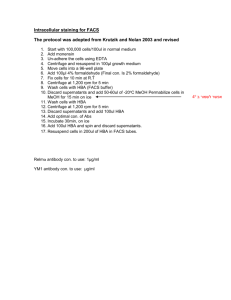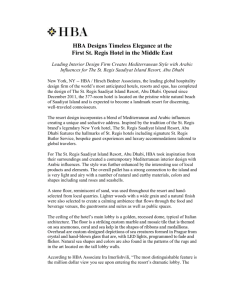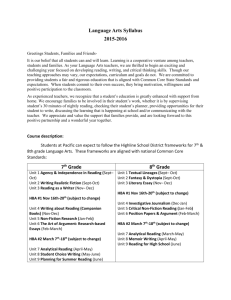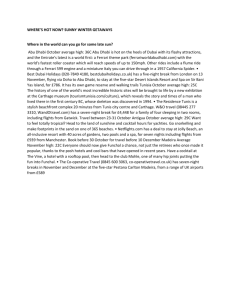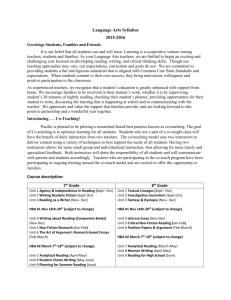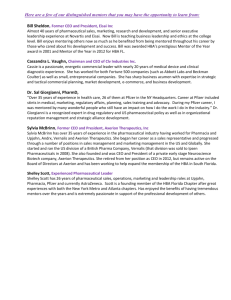The Business of Interior Design in a Global Down Market
advertisement
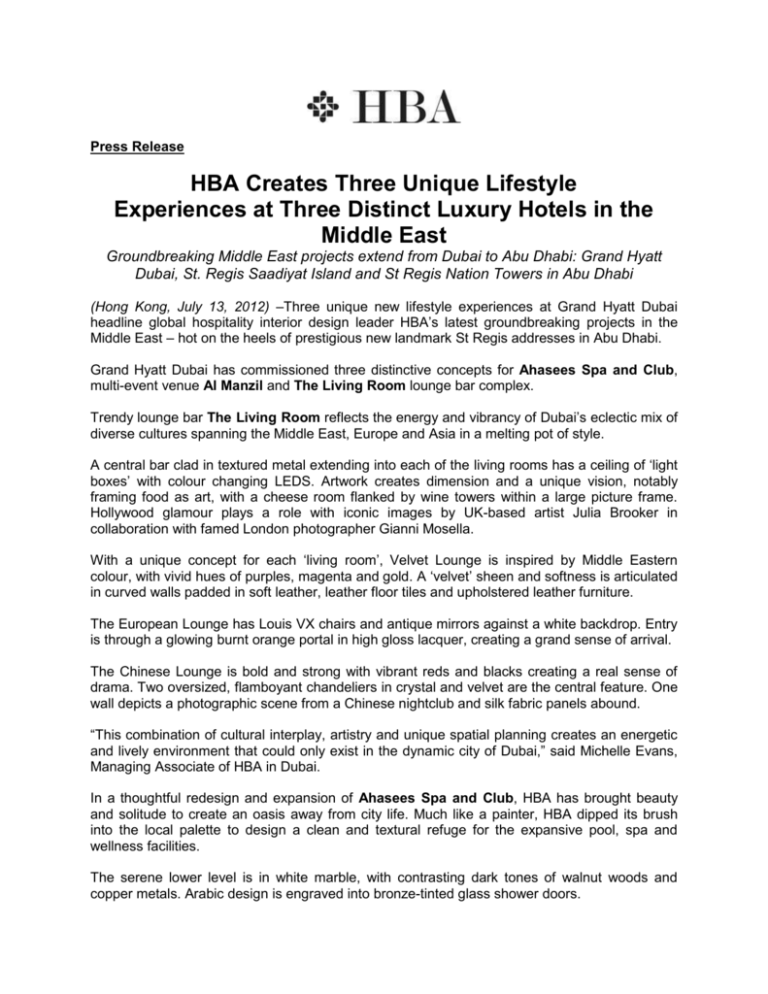
Press Release HBA Creates Three Unique Lifestyle Experiences at Three Distinct Luxury Hotels in the Middle East Groundbreaking Middle East projects extend from Dubai to Abu Dhabi: Grand Hyatt Dubai, St. Regis Saadiyat Island and St Regis Nation Towers in Abu Dhabi (Hong Kong, July 13, 2012) –Three unique new lifestyle experiences at Grand Hyatt Dubai headline global hospitality interior design leader HBA’s latest groundbreaking projects in the Middle East – hot on the heels of prestigious new landmark St Regis addresses in Abu Dhabi. Grand Hyatt Dubai has commissioned three distinctive concepts for Ahasees Spa and Club, multi-event venue Al Manzil and The Living Room lounge bar complex. Trendy lounge bar The Living Room reflects the energy and vibrancy of Dubai’s eclectic mix of diverse cultures spanning the Middle East, Europe and Asia in a melting pot of style. A central bar clad in textured metal extending into each of the living rooms has a ceiling of ‘light boxes’ with colour changing LEDS. Artwork creates dimension and a unique vision, notably framing food as art, with a cheese room flanked by wine towers within a large picture frame. Hollywood glamour plays a role with iconic images by UK-based artist Julia Brooker in collaboration with famed London photographer Gianni Mosella. With a unique concept for each ‘living room’, Velvet Lounge is inspired by Middle Eastern colour, with vivid hues of purples, magenta and gold. A ‘velvet’ sheen and softness is articulated in curved walls padded in soft leather, leather floor tiles and upholstered leather furniture. The European Lounge has Louis VX chairs and antique mirrors against a white backdrop. Entry is through a glowing burnt orange portal in high gloss lacquer, creating a grand sense of arrival. The Chinese Lounge is bold and strong with vibrant reds and blacks creating a real sense of drama. Two oversized, flamboyant chandeliers in crystal and velvet are the central feature. One wall depicts a photographic scene from a Chinese nightclub and silk fabric panels abound. “This combination of cultural interplay, artistry and unique spatial planning creates an energetic and lively environment that could only exist in the dynamic city of Dubai,” said Michelle Evans, Managing Associate of HBA in Dubai. In a thoughtful redesign and expansion of Ahasees Spa and Club, HBA has brought beauty and solitude to create an oasis away from city life. Much like a painter, HBA dipped its brush into the local palette to design a clean and textural refuge for the expansive pool, spa and wellness facilities. The serene lower level is in white marble, with contrasting dark tones of walnut woods and copper metals. Arabic design is engraved into bronze-tinted glass shower doors. The new upper level Spa is in soft tones and finishes - its timber flooring with accentuated grain giving an 'aged' look and feel. Colour tones are complimented by dusky pink rugs. Tactile soft surfaces were created using silk wall paneling and leather – on staircase handrails and reception tabletops. In the relaxation rooms, a sanctuary of calm prevails as customized stone cut angled walls remind guests of the rich local culture. Sand dune photographs with Arabic poetry inscribed are also on display throughout the space. HBA also delved deep into local cultural, artistry, craft and lifestyle when designing Al Manzil, Grand Hyatt Dubai’s ‘Residence’ multi-event venue for meetings and events. It feels like a wellcurated residential home – housing six venues including meeting rooms, a lounge, family room, conservatory and open show kitchen in the dining room. In local culture, Arabic homes are often built around a central courtyard. Similarly, guests enter Al Manzil through grand timber paneled doors into a central courtyard. To one side is an open kitchen with lounge and dining areas. Meeting facilities open off to either side, followed by the conservatory. Al Manzil is richly curated with Arabic rhythms and patterns, inspired by delicate designs found in door-hardware around the city and meticulously hand-crafted local jewelry. An artwork collection is fashioned by Arabic motifs with a contemporary twist. Skylights bathe the spaces in natural light. Strong contrasting colours and finishes are in dark red onyx marble, red velvets, bronze metal, dark timbers and embossed leathers in buttery cream and tan. The kitchen, the heart of every home, is clad in warm honey onyx with dark timber. Cookbooks, spices, oils and beautifully coppered pots and pans are displayed and freshly potted herbs add an aromatic experience. “Ultimately, a mélange of custom designed and locally sourced fabric and furniture creates a meticulously curated sense of place, alive in local flavour, art, history and culture,” said Evans. In neighbouring Abu Dhabi, HBA has combined Mediterranean style with Arabic influences for the first St. Regis Hotel in the Middle East, St. Regis Saadiyat Island, Abu Dhabi. Timeless elegance underlines the 380-room hotel located on the pristine white natural beach of Saadiyat, a beautiful natural island just 20 minutes from Abu Dhabi International airport and seven minutes from downtown Abu Dhabi. The island is currently being transformed into a new cultural centre of the Arabian world – complete with Louvre and Guggenheim Museums as well as a world-class performing arts center and concert hall and New York University campus. At the new hospitality landmark, St. Regis Saadiyat Island “promises more than a respite from the urban – it promises a freedom from concerns,” says HBA Atlanta Associate Ira Imerlishvili. “The purpose of a seaside resort is to invite the guest into relaxation, pleasure and comfort. The design is more than visual enrichment – it is essential to the guest experience.” HBA took inspiration from the surroundings to create a contemporary Mediterranean interior design with Arabic influences, enhanced by local products and elements. “The overall palette has a strong connection to the island, light and airy with natural and earthy materials, colours and shapes including sand roses and sea swells,” said Mr. Imerlishvili. A stone floor reminiscent of sand was used throughout. Lighter woods with a wide grain and a natural finish create a calming ambience through food and beverage outlets, guestrooms and public spaces. “But the most distinguishable feature is the million dollar view upon entering the property,” said Mr Imerlishvili. “The entire back wall of the lobby is made of frameless glass overlooking the sea, offering amazing unobstructed views unlike any other in Abu Dhabi.” Natural materials create a palette of pale gold, cream and darker tones of slates and marbles at the serene Iridium Spa. In contrast, The St. Regis Nation Towers offers a defining urban hotel experience in Abu Dhabi, refined and elegant as luxury hospitality in any global city. As a world capital of finance, trade and travel, Abu Dhabi has extremely high expectations of luxury and sophistication in design and extravagance and The St. Regis Nation Towers does not disappoint. The distinctive addition to the Abu Dhabi skyline is an ultra-sleek glass and steel landmark of two skyscrapers of 268 and 233 metres linked by the world’s highest sky bridge. The St. Regis Nation Towers occupies the top floors of the smaller tower with 228 distinctive guestrooms and 55 grand suites, including one on the connecting bridge. HBA delivered interior architecture worthy of both the storied brand and this hotel’s remarkable location along the city’s garden-lined coastal boulevard. Rather than embellishing a classical European-style design with local detailing, HBA created an imaginary historical starting point: an Art Deco past. This raised the question: what would classical Art Deco have looked like if it had been expressed in Abu Dhabi during the 1920s and 30’s? “With very few local references, we looked to the colours of the sands, and the traditional foods, spices, arts and crafts that flourished in the markets of the time – imaginatively elevating and applying them to a refined, gazelle-like style,” said Imerlishvili HBA then re-envisioned that imagined past, modernising it for a 21st Century city. The lobby is a peerless example of this new Arabian Deco. Entry is akin to stepping into a musical movement – with an organic, almost lyrical flow of lines. Large fluted columns, a nod to classical Deco, soar up the atrium. An exquisite railing on the staircase and mezzanine is patterned in Arabesque lace metal. Chandeliers are inspired by glittering Arabian lanterns. The result is a fusion of intricate Arabian art with the clean geometry of Art Deco. The St. Regis Bar pays homage to Bedouin influences with murals themed on a traditional desert horse race and the Bedouin Deco intimacy of a grand tent. A Champagne Bar is without walls — like an open secret – with pink marble tops. The centerpiece is an innovative chandelier of hundreds of luminous bubbles, as if rising from a Champagne flute. Fine dining restaurant Villa Tuscana is also a reinvention of a mythical Arabian Deco past, designed as a century-old Tuscan estate with terraces, vaulted ceilings, tall arched windows of small glass panes, frescoes and exposed beams. The Ballroom is opulent with gold accenting floating over a custom carpet of rich gold, with a motif like the domes of a mosque, and crystal chandelier designed after a bouquet of desert roses. Guestrooms are Deco showpieces – from over-scaled crown moulding to bed posts and subtle swooping patterns in soft gold carpeting. At the foot of the beds are antique trunks in leather and bronze, topped with tasseled pillows, suggesting a treasure chest reference to the local culture. Guestroom baths exude the opulence of a royal suite with walls, floors and ceilings in white stone mosaic. Taken in combination, the two St. Regis properties in Abu Dhabi give a sense of HBA’s range, wildly different in approach – The St. Regis Saadiyat Island being beach resort-inspired and The St. Regis Nation Towers a formal, elegant urban hotel. Yet in both, HBA’s ability to blend cultural detail, conceptual creativity and artistic sensibility has resulted in exceptional, brand reinforcing properties. HBA has been increasingly active in the Middle East since opening a dedicated new office in Dubai in 2000. High-end projects have also included Taj Palace Dubai, Qasr Al Sarab Desert Resort by Anatara, Ritz Carlton Dubai and Amethyst Lounge Beirut. - Ends About HBA World-renowned as the “Number 1 Hospitality Design Firm” (Interior Design) and honored in 2012 by the Hospitality Design Awards and Gold Key Awards, in 2011 by the Perspective Awards, the Boutique Design Awards and the European Hotel Design Awards; HBA/Hirsch Bedner Associates, unveils the world’s most anticipated hotels, resorts, and spas. Leading the hospitality interior design industry since 1965, HBA remains keenly attuned to the pulse of changing industry trends governed by today's sophisticated traveler. The company’s international presence, depth of experience, and detailed industry knowledge enables them to identify interior design trends at their source, make definitive predictions about new directions and innovations, and influence design standards at a global level. HBA’s ultimate objective is to add value, raise standards and enhance the brand of a project's owner and operator. HBA creates the signature look of traditional luxury brands, independent contemporary boutiques, urban resort spas, world-class residences, restaurants, casinos, and cruise ships. From continent to continent, each HBA interior is the result of a unique and sensitive response to location, architecture, and client vision. With over 900 designers around the globe in 16 offices and a recent expansion in Asia, HBA is a true global company with more than 75% of its employees now outside the United States. HBA’s international presence, combined with its extensive knowledge of the interior design industry, has facilitated the ability to rewrite the language of design with each new project. For HBA in Los Angeles, Atlanta, San Francisco, London, Hong Kong, Shanghai, Tokyo, Singapore, Brisbane, Melbourne, New Delhi, Dubai Thailand, Moscow, Istanbul and Manila, visit www.hba.com Issued by Grebstad Hicks Communications on behalf of HBA. For interviews, images, renderings and design details please contact: Phil Boyle / Joshua Shi Grebstad Hicks Communications – Shanghai Tel: (86) 21 5213 3030 Email: phil.boyle@ghcasia.com / joshua.shi@ghcasia.com Stephen Allington Grebstad Hicks Communications - Hong Kong Tel: (852) 3163 0125 Email: stephen.allington@ghcasia.com
